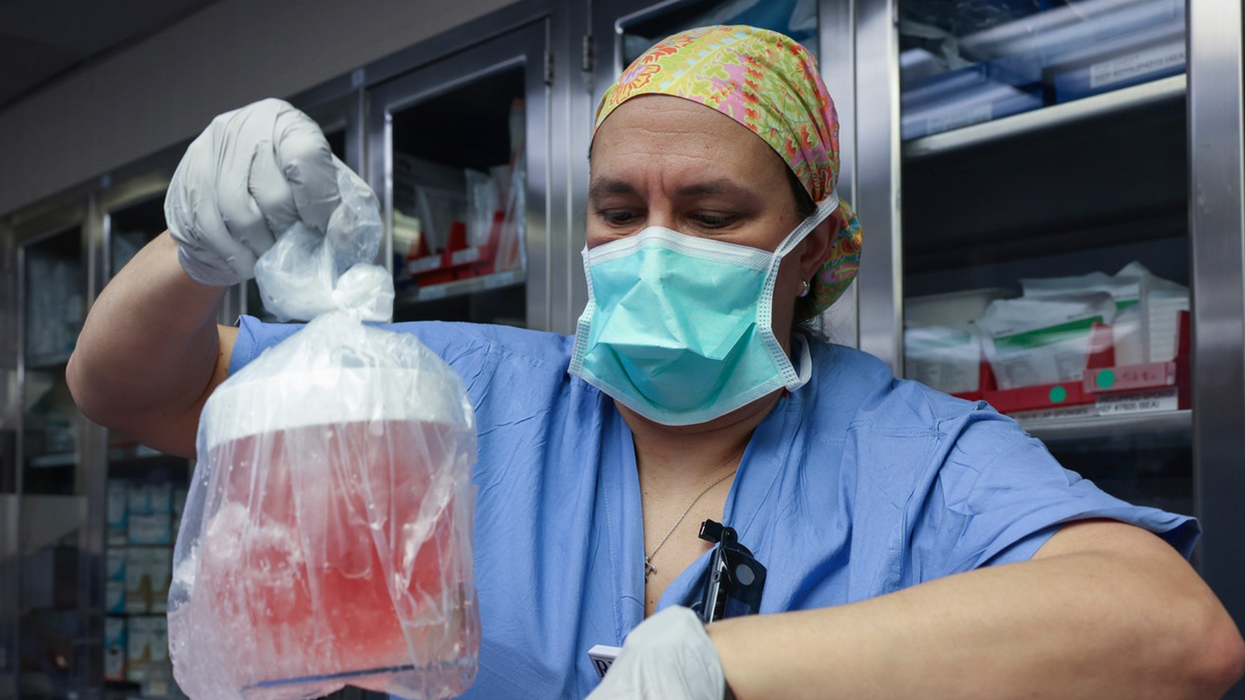Worried About Eating GMOs? That’s Not the Real Problem

Farmers harvest rice in a field.
The 21st century food system is awash in ethical issues. To name just a handful: There's the environmental impacts of farming, the human health effects of diets based on animal products and processed foods, the growing clamor around food waste, and the longstanding concerns about agricultural labor. The last decade has seen the emergence of "ethical consumption," as people have been encouraged to avoid products that are associated with animal cruelty or unfair to farmers.
Misguided concerns about GMOs are missing the point altogether and distracting from a far more substantive ethical problem.
But consumers have never been so ignorant about where food comes from, and they are vulnerable to oversimplifications and faulty messaging. Many would include the first generation of crops from agricultural applications of recombinant DNA methods for genetic improvement—so called GMOs—among the foods they should avoid for ethical reasons. Unfortunately, these misguided concerns are missing the point altogether and distracting from a far more substantive ethical problem.
As we stand on the precipice of a new era in food and biotechnology – crops and animals with genomes altered through gene editing – it is more important than ever to let go of unnecessary fears and to pay attention to the real hazards of agricultural innovation.
But first, as a bioethicist with almost 40 years of experience working on issues in the food system, let me stress the overall context and rationale for trying to make changes in plant and animal genetics. Doing so, whether through conventional breeding or biotechnology, allows producers to meet the challenges of seasonal climate differences and increase yields.
And just because a food was created through ordinary plant breeding vs. genetic modification does not automatically make it safe. Things can and do go wrong in ordinary plant breeding, such as with potatoes and tomatoes. These both produce toxins in the green parts of the plant, and breeders exercise caution to ensure that toxins aren't transferred to edible parts.
Despite real risks, there is no regulatory oversight that protects us from these known hazards. We rely on the professional ethics of agricultural scientists. And GMOs are, in comparison, much more carefully tested and regulated. The claim that they are "unregulated" is just false.
We should not ignore the role that all gene technologies have played in displacing small farmers, depleting rural communities, and shifting economic control.
I do want to shift the public's attention away from the anti-GMO debate to more substantive questions about contemporary agriculture that really have little to do with where the genes in their food came from, or how they got there.
No matter how important genetic improvements might be in terms of total global food production, we should not ignore the role that all gene technologies—including breeding—have played in displacing small farmers, depleting rural communities and shifting economic control of agriculture into a small circle of powerful actors. Globally, these changes have had disproportionately harmful effects on women and people of color.
Combined with mechanization and chemicals, gene technologies have freed planters from their dependence on impoverished and poorly educated field hands, but they did nothing to help the fieldworkers transition to a new line of work. These are the real problems that deserve the public's and the science community's attention, not the overly narrow worries about eating GMOs.
But these problems are viewed as "not ours" by agricultural insiders, and they continue to be ignored by scientists whose focus is solely on biology. Many of the concerns that are today viewed as "urban problems" or "social issues" have origins in agriculture. For example, in California tomatoes, the development of mechanical harvesting led to a rapid concentration of ownership and the displacement of thousands of field hands. In the South, similar technologies displaced black farmers working land owned by whites, causing migration to urban centers and unskilled jobs. I must fault the science community for a lack of willingness to even take the thrust of these more socially oriented critiques seriously.
The new suite of tools for genetic modification that go under the name "gene editing" promise greater precision. They should allow scientists to target the locus for new genes in a plant or animal genome, and minimize the chance for causing unwanted impacts on gene functioning. This added precision is reducing some of the uncertainties in the mind of technology developers, and they have been expressing hope that their own confidence will be shared by regulators and by the public at large. In fact, the U.S. government recently issued a statement that gene-edited crops do not require additional regulation because they're just as safe as crops produced through conventional breeding.
It is indeed possible that the public doubts about genetically modified food will be assuaged by this argument. We can only wait and see. Whether or not gene editing will lead to more reflection about agriculture's complicity in problems of economic inequality or structural racism depends much more on the culture of the science community than it does on the technology itself.
Urinary tract infections account for more than 8 million trips to the doctor each year.
Few things are more painful than a urinary tract infection (UTI). Common in men and women, these infections account for more than 8 million trips to the doctor each year and can cause an array of uncomfortable symptoms, from a burning feeling during urination to fever, vomiting, and chills. For an unlucky few, UTIs can be chronic—meaning that, despite treatment, they just keep coming back.
But new research, presented at the European Association of Urology (EAU) Congress in Paris this week, brings some hope to people who suffer from UTIs.
Clinicians from the Royal Berkshire Hospital presented the results of a long-term, nine-year clinical trial where 89 men and women who suffered from recurrent UTIs were given an oral vaccine called MV140, designed to prevent the infections. Every day for three months, the participants were given two sprays of the vaccine (flavored to taste like pineapple) and then followed over the course of nine years. Clinicians analyzed medical records and asked the study participants about symptoms to check whether any experienced UTIs or had any adverse reactions from taking the vaccine.
The results showed that across nine years, 48 of the participants (about 54%) remained completely infection-free. On average, the study participants remained infection free for 54.7 months—four and a half years.
“While we need to be pragmatic, this vaccine is a potential breakthrough in preventing UTIs and could offer a safe and effective alternative to conventional treatments,” said Gernot Bonita, Professor of Urology at the Alta Bro Medical Centre for Urology in Switzerland, who is also the EAU Chairman of Guidelines on Urological Infections.
The news comes as a relief not only for people who suffer chronic UTIs, but also to doctors who have seen an uptick in antibiotic-resistant UTIs in the past several years. Because UTIs usually require antibiotics, patients run the risk of developing a resistance to the antibiotics, making infections more difficult to treat. A preventative vaccine could mean less infections, less antibiotics, and less drug resistance overall.
“Many of our participants told us that having the vaccine restored their quality of life,” said Dr. Bob Yang, Consultant Urologist at the Royal Berkshire NHS Foundation Trust, who helped lead the research. “While we’re yet to look at the effect of this vaccine in different patient groups, this follow-up data suggests it could be a game-changer for UTI prevention if it’s offered widely, reducing the need for antibiotic treatments.”
MILESTONE: Doctors have transplanted a pig organ into a human for the first time in history
A surgeon at Massachusetts General Hospital prepares a pig organ for transplant.
Surgeons at Massachusetts General Hospital made history last week when they successfully transplanted a pig kidney into a human patient for the first time ever.
The recipient was a 62-year-old man named Richard Slayman who had been living with end-stage kidney disease caused by diabetes. While Slayman had received a kidney transplant in 2018 from a human donor, his diabetes ultimately caused the kidney to fail less than five years after the transplant. Slayman had undergone dialysis ever since—a procedure that uses an artificial kidney to remove waste products from a person’s blood when the kidneys are unable to—but the dialysis frequently caused blood clots and other complications that landed him in the hospital multiple times.
As a last resort, Slayman’s kidney specialist suggested a transplant using a pig kidney provided by eGenesis, a pharmaceutical company based in Cambridge, Mass. The highly experimental surgery was made possible with the Food and Drug Administration’s “compassionate use” initiative, which allows patients with life-threatening medical conditions access to experimental treatments.
The new frontier of organ donation
Like Slayman, more than 100,000 people are currently on the national organ transplant waiting list, and roughly 17 people die every day waiting for an available organ. To make up for the shortage of human organs, scientists have been experimenting for the past several decades with using organs from animals such as pigs—a new field of medicine known as xenotransplantation. But putting an animal organ into a human body is much more complicated than it might appear, experts say.
“The human immune system reacts incredibly violently to a pig organ, much more so than a human organ,” said Dr. Joren Madsen, director of the Mass General Transplant Center. Even with immunosuppressant drugs that suppress the body’s ability to reject the transplant organ, Madsen said, a human body would reject an animal organ “within minutes.”
So scientists have had to use gene-editing technology to change the animal organs so that they would work inside a human body. The pig kidney in Slayman’s surgery, for instance, had been genetically altered using CRISPR-Cas9 technology to remove harmful pig genes and add human ones. The kidney was also edited to remove pig viruses that could potentially infect a human after transplant.
With CRISPR technology, scientists have been able to prove that interspecies organ transplants are not only possible, but may be able to successfully work long term, too. In the past several years, scientists were able to transplant a pig kidney into a monkey and have the monkey survive for more than two years. More recently, doctors have transplanted pig hearts into human beings—though each recipient of a pig heart only managed to live a couple of months after the transplant. In one of the patients, researchers noted evidence of a pig virus in the man’s heart that had not been identified before the surgery and could be a possible explanation for his heart failure.
So far, so good
Slayman and his medical team ultimately decided to pursue the surgery—and the risk paid off. When the pig organ started producing urine at the end of the four-hour surgery, the entire operating room erupted in applause.
Slayman is currently receiving an infusion of immunosuppressant drugs to prevent the kidney from being rejected, while his doctors monitor the kidney’s function with frequent ultrasounds. Slayman is reported to be “recovering well” at Massachusetts General Hospital and is expected to be discharged within the next several days.
